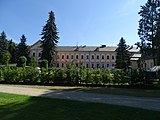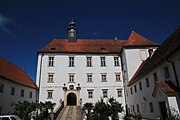Wormbrand Stuppach
The Wurmbrand-Stuppach house is one of the most important Austrian aristocratic families and belongs to the Lower Austrian nobility . The lords, barons and counts von Wurmbrand-Stuppach were part of the high nobility .
history
Origins
The family appears for the first time in 1194 with Leupold the Wurmbrant in the document of Archbishop Adalbert von Salzburg , in which the latter granted permission to found the parish of Kirchau (today the municipality of Warth ). The ruins of Wurmbrand Castle, which dates back to the 12th century, are located near Krumbach Castle in Bucklige Welt .

The area of the Bucklige Welt was still a closed woodland in the year 1000, which was almost uninhabited. The colonization began after the victory of Count Gottfried von Wels-Lambach over the Magyars in 1042 near Pitten , when he took over the area from Emperor Heinrich III. received as a fief. The County of Pitten came to the Counts of Formbach through his daughter . Eckbert II von Formbach-Neuburg commissioned ministerials to develop the country, including the Knights von Wurmbrand and Poppo de Stuppach, mentioned around 1155 . When Count Eckbert III. von Formbach-Neuburg died in 1158, the entire area fell to the Margraves of Styria . As a result, the Wurmbrand were enfeoffed with Stuppach Castle .
With Helmwig worm Brant to Salloder (at Gloggnitz , Lower Austria), the documentary occurred on 25 July 1322 and his brother Henry worm Brant of Stuppach (also at Gloggnitz), whose grave stone from the year 1265 in the church of the former Benedictine monastery Gloggnitz is , the safe trunk row begins . The Wurmbrand remained in the possession of Stuppach until 1659. In these five centuries there were repeated disputes with the neighboring monastery of Gloggnitz. Hans Ehrenreich Graf von Wurmbrand sold the Stuppach estate to Matthias Wegerle von Walsegg in 1659 (whose family kept it until after the death of Franz von Walsegg in 1827).
Own
In 1592 Hieronymus Wurmbrandt, the hereditary chef in Styria, bought Vöstenhof Castle and had it converted into today's Renaissance castle in 1597. But already in 1621 it went out of the family.
The castle Steyerberg in Warth (the hunchback world) was d in 1600 from Ehrenreich of Wurmbrand to Stuppach. Ä. (1558 - after 1620), who had it expanded extensively, u. a. with arcades and fortifications; it could not be conquered by the Turks in 1683. In 1607 he bought Stickelberg Castle (now in ruins, in the Hollenthon municipality ). After 1791 there were various tenants. After the death of Count Degenhard von Wurmbrand-Stuppach († 1965) his daughter Leonora inherited the castle; she married the American Robert Miller in 1947 and Thomas-Alfred Wertheimer Edler von Wertheimstein in 1965. The castle, which for a long time was the headquarters of the head of the Wurmbrand-Stuppach family, is now run by her son Dr. Paul Miller lives in.
In 1602, Sibilla von Wurmbrand bought Castle Reitau in Styria, which was sold in 1822 by Franz Carl Graf von Wurmbrand. From 1789 to 1914, the Reitau line also owned Oberradkersburg Castle in the former Lower Styria .
In 1658, Hans Ehrenreich von Wurmbrand acquired Schwarzenbach Castle in Lower Austria ; However, it was sold to the Esterházy house in 1680 , which still owns the ruin, which had been decaying since the 19th century.
The Styrian Neuhaus Castle was owned from 1663 to 1809 .
In 1694, the Wurmbrand acquired Altschielleiten Castle in Styria, but began to rebuild the Baroque Schielleiten Castle at the foot of the castle around 1730 . With this move the castle was abandoned, then due to the introduction of the roof tax the roof was removed and all usable building materials were sold, whereby the castle became a ruin after 1813. However, the imperial counts had taken on financially with the new building, which is why it remained unfinished. Schielleiten came into the possession of the Marchese Tacoli through the marriage of Countess Anna Maria von Wurmbrand-Stuppach in 1906.
Count Johann Wilhelm von Wurmbrand married Juliane Dorothea von Limpurg-Gaildorf in 1700, one of the numerous co-heirs of the direct imperial Swabian rule of Limpurg , based at Gaildorf Castle .
In 1711 the Styrian Maßenburg came to Maria Anna Countess Wurmbrand; it remained in the family's possession until 1806, to which it was returned from 1845 to 1855.
In 1728 Johann Wilhelm Graf Wurmbrand-Stuppach bought Hirschstetten Castle near Vienna, which remained in the possession until 1799.
In 1755, Count Franz Josef von Wurmbrand acquired Großlobming Castle , which was sold in 1827.
Stubenberg Castle in Styria was acquired in 1815 and came as a dowry for two daughters who had entered the order to the Franciscan Missionaries of Mary, who converted it into St. Joseph's Monastery in 1925.
Historical meaning
During the 17th and 18th centuries, the family achieved notoriety and fame through their services in the Turkish and Balkan Wars. She served the Habsburg imperial family in various functions. Ehrenreich d. Ä. von Wurmbrand zu Stuppach (1558 - approx. 1620) was raised to the baron status in 1607. In 1682 his children were raised to the rank of count. In 1701 his great-grandson, the President of the Reichshofrat , Count Johann Josef Wilhelm (1670–1750), and his brothers were given the status of imperial count with the title “High and Well Born”. In 1726 he was accepted as a personalist in the Franconian Reichsgrafenkollegium , against the promise of acquiring an imperial immediate territory and taking over a status-appropriate register notice on the imperial burdens. Finally, in 1774/75, after the Limpurg inheritance dispute was over, a splinter portion of the county of Limpurg, which was immediately part of the empire, was recognized as the corresponding territory.
With the Rhine Confederation Act and the dissolution of the Holy Roman Empire of the German Nation in 1806, the family became noblemen in the German Confederation as a result of the mediation and, according to the Bundestag resolution of February 13, 1829, its members carried the title of illustrious . The house Wurmbrand-Stuppach thus belongs to the high nobility and can be found in the Genealogical Handbook of the Nobility , Volume XVII "Princely Houses", in Section II.
Lines
The President of the Reichshof Council, Count Johann Josef Wilhelm (1670–1750) donated the "older line". This divided among his great-grandchildren into three branches, the first of which was founded by Hereditary Count Ernst Heinrich Gundaccar (1804–1846), resident at Steyersberg Castle, but with his great-grandson, Count Degenhard (1893–1965), became extinct in the male line; the second goes back to the brother of the Hereditary Count , Johann Wilhelm (1806-1884), who was temporarily based in Liblín in the Bohemian district of Rokitzan , this branch is still flourishing with the current head of the house, Count Ernst Gundaccar (* 1946) and his sons, The residence is the hunting lodge in Frohsdorf ; the third branch of the brother Ferdinand (1807–1886) also has a few descendants.
A cousin of the father of Count Johann Josef Wilhelm, Georg Andreas "the Younger" (1648–1702) founded the Schielleitener line, which died out in 1901, and his brother Wolfgang (1652–1704) founded the line at Castle Reitau ( 1602–1822 family property), which also owned Oberradkersburg Castle from 1789 to 1914 and became extinct in the male line in 1928.
Liblín , Czech Republic
Reitau , Styria
Oberradkersburg , Slovenia
According to historical nobility law, the descendants of the house carry the title "Count von Wurmbrand and Stuppach, Baron von Steyersberg, Stikkelsberg, Reydenau, Neuhauß and Saxenbrunn" or the respective female form. Today the family has only a few members.
coat of arms

Blazon : The family coat of arms shows a black dragon with a spiked tail, which holds a branch in its throat that is burning on both sides and flames of fire emerge from its ears. The shield image on the helmet with black and silver covers .
Significant namesake
- Melchior von Wurmbrand († after 1637), Freiherr zu Juleta , Swedish colonel
- Johann Joseph Wilhelm von Wurmbrand-Stuppach (1670–1750), President of the Reichshof Council
- Christian Siegmund von Wurmbrand-Stuppach (1673–1737)
- Casimir Heinrich von Wurmbrand-Stuppach (1680–1749), on Steyersberg
- Ernst Reichsgraf von Wurmbrand-Stuppach (1838–1917), officer of the K. u. k. army
- Franz Joseph von Wurmbrand-Stuppach (1737–1806) , Austrian diplomat
- Franz Joseph von Wurmbrand-Stuppach (1753–1801) , Austrian civil servant and politician
- Ladislaus Gundacker von Wurmbrand-Stuppach (1838–1901), Governor of Styria
- Stephanie von Wurmbrand-Stuppach (1849–1919), pianist and composer
- Maria Anna von Wurmbrand-Stuppach (1914–2003), known as Etti Plesch, author of the memoir "Horses and Husbands"
literature
- Constantin von Wurzbach : Wurmbrand-Stuppach, the counts, genealogy . In: Biographisches Lexikon des Kaiserthums Oesterreich . 58th part. Kaiserlich-Königliche Hof- und Staatsdruckerei, Vienna 1889, pp. 290–293 ( digitized version ).
- Constantin von Wurzbach : Wurmbrand, coat of arms of the counts . In: Biographisches Lexikon des Kaiserthums Oesterreich . 58th part. Kaiserlich-Königliche Hof- und Staatsdruckerei, Vienna 1889, p. 304 ( digitized version ).
- Constantin von Wurzbach : Wurmbrand, sources on the history of the house . In: Biographisches Lexikon des Kaiserthums Oesterreich . 58th part. Kaiserlich-Königliche Hof- und Staatsdruckerei, Vienna 1889, p. 304 ( digitized version ).
- Genealogical manual of the nobility , “Adelslexikon” Volume XIV, Volume 131 of the complete series, pp. 421-423, C. A. Starke Verlag, Limburg (Lahn) 2003, ISSN 0435-2408
- Max Kübeck: "The blue brooch: Secret of a family." Czernin Verlag, Vienna 2015, ISBN 978-3-7076-0489-4 .
Web links
- Web presence of the Wurmbrand-Stuppach family
- Stuppach Castle
- Gloggnitz Castle
- Family genealogy
- genealogy.euweb
- Entry via Schwarzenbach Castle to Burgen-Austria
- Pedigree of Count Leopold von Wurmprand
Individual evidence
- ↑ Salzburger Urkundenbuch 2, p. 666. No. 492
- ↑ Prof. Hans von Zwiedinek “Das reichsgräfl. Wurmbrand'sche Haus- und Familienarchiv zu Steyersberg ”, Graz 1906, publication of the histor. Provincial Commission for Styria
- ^ Genealogical handbook of the nobility, Volume XVII - Princely houses
- ↑ Constantin von Wurzbach : Wurmbrand-Stuppach, Stephanie Gräfin . In: Biographisches Lexikon des Kaiserthums Oesterreich . 58th part. Kaiserlich-Königliche Hof- und Staatsdruckerei, Vienna 1889, p. 312 ( digitized version ) .;






